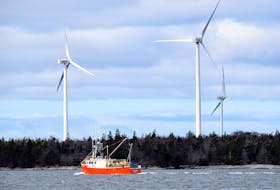PICTOU COUNTY - Comparing Northern Pulp’s effluent treatment to those used at other pulp mills is an “apples to donuts comparison,” says an industry expert.
The process for treating effluent has come under scrutiny as the Pictou County mill prepares to replace the Boat Harbour treatment facility that the province has ordered closed by 2020.
The Northumberland Fishermen’s Association has called upon the Minister of the Environment to approve a wastewater treatment facility for Northern Pulp, entirely contained on land. They have voiced strong disapproval for an open-ended pipe that would release any effluent into the Northumberland Strait, citing fears of endangering the ecosystem and wildlife – including lobster, crab, scallop, herring, mackerel and ground fish.
However, experts such as Guy Martin beg to differ. Martin is an engineer, and the principal consultant for process and environment with KSH Solutions, an engineering firm in Montreal.
Martin said one of the cases he has heard for a closed-loop system for Northern Pulp is that other pulp mills use closed-loop effluent treatment, such as pulp mills in Meadow Lake, Sask., and Tumut, New South Wales, Australia.
According to Martin, one of the principal reasons a closed-loop system is not applicable at Northern Pulp is that the technology to make a closed loop system happen for Northern Pulp doesn’t exist.
“There are pulp mills out there that used a closed-loop system, like the one that operates in Meadow Lake, Saskatchewan, but we’re talking about a different process there,” said Martin.
The process in use at Northern Pulp is the kraft process, producing bleached pulp – one that produces effluent streams that cannot be recycled in the process. The majority of effluent produced by the process at Northern Pulp comes from the bleach plant, which is why an open system is required.
Although there have been attempts at creating a closed-loop system, such as one done by Canadian Ingenuity in the early 1970s, near Thunder Bay, Ont., “they’ve all failed for a variety of reasons,” said Martin, who noted that the first time it was achieved, “it was shut down because of operational concerns with the fouling of equipment, corrosion and so on.”
Martin said there have been intervals of closure achieved at other mills that use the bleach kraft process, such as a mill in California owned by Louisiana Pacific, but even that facility used a slightly different bleaching process, and “they had to open things back up, because the equipment was in disarray, and had to be cleaned and maintained.”
According to Martin, the mill at Meadow Lake makes mechanical pulp, using mechanical action to separate fibres, which produces a brownish pulp used in things like newsprint-grade paper, or paper filler. That process uses a great deal less water than the one at Northern Pulp.
As for Tumut, Martin said it uses a similar kraft pulping technique that uses chemicals to dissolve the lignin in wood – the difference is that the mill in Tumut produces unbleached pulp. This kind of paper goes to make liners and shipping boxes.

![['Employees at Northern Pulp voted Wednesday on a new agreement with their employer. ADAM MACINNIS – THE NEWS']](https://saltwire.imgix.net/narrow-vote-for-deal-2101750.jpg?cs=srgb&fit=crop&h=568&w=847&dpr=1&auto=format%2Ccompress%2Cenhance)







